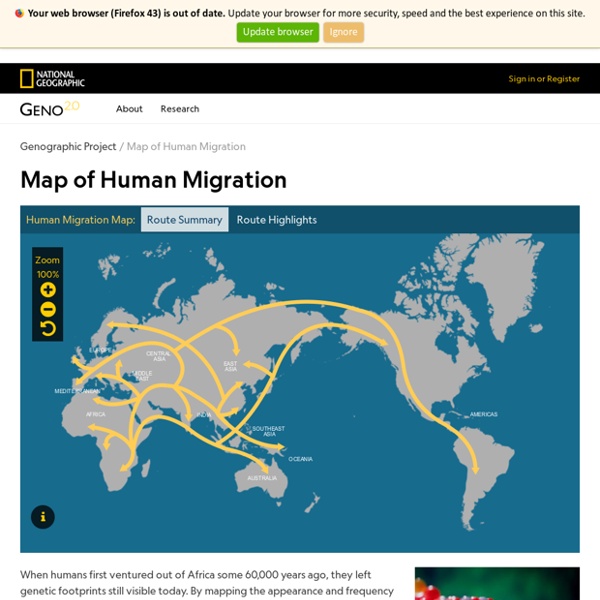Earth - Your life on earth
Explore BBC Earth's unique interactive, personalised just to you. Find out how, since the date of your birth, your life has progressed; including how many times your heart has beaten, and how far you have travelled through space. Investigate how the world around you has changed since you've been alive; from the amount the sea has risen, and the tectonic plates have moved, to the number of earthquakes and volcanoes that have erupted.
Human mitochondrial DNA haplogroup
Hypothesized world map of human migrations, with the North Pole at center. Africa, harboring the start of the migration, is at the top left and South America at the far right. Migration patterns are based on studies of mitochondrial (matrilinear) DNA. Letters represent haplogroups while colors and numbers represent thousands of years before present. Suggested migratory route of the "Out of Africa" migration according to Mitochondrial DNA In human genetics, a human mitochondrial DNA haplogroup is a haplogroup defined by differences in human mitochondrial DNA.
MIGRATION FLOWS - EUROPE
DISCLAIMER: Base Map Source: ESRI. This map is for illustration purposes only. Names and boundaries on this map do not imply official endorsement or acceptance by IOM. ــــــــــــــــــــــــــــــــــــــــــــــــــــــــــــــــــــــــــــــــــــــــــــــــــــــــــــــــــــــــــــــــــــــــــــــــــــــــــــــــــــ Since January 2016, 187,651 people were reported to be arriving to Europe, by land and sea.
The Origin of Humans Is Surprisingly Complicated
HUMAN FAMILY TREE used to be a scraggly thing. With relatively few fossils to work from, scientists' best guess was that they could all be assigned to just two lineages, one of which went extinct and the other of which ultimately gave rise to us. Discoveries made over the past few decades have revealed a far more luxuriant tree, however—one abounding with branches and twigs that eventually petered out. This newfound diversity paints a much more interesting picture of our origins but makes sorting our ancestors from the evolutionary dead ends all the more challenging, as paleoanthropologist Bernard Wood explains in the pages that follow.
The Origin of Us
Who are we? Where did we come from? Why are we here? The age-old question of our origin has been baffling mankind for centuries. For most of our history, it was widely accepted that man had been created by an omnipresent, omnipotent, God or Gods.
Human Y-chromosome DNA haplogroup
Dominant Y-chromosome haplogroups in pre-colonial world populations, with possible migrations routes according to the Coastal Migration Model. In human genetics, a human Y-chromosome DNA haplogroup is a haplogroup defined by differences in the non-recombining portions of DNA from the Y chromosome (called Y-DNA). It represents human genetic diversity based on single-nucleotide polymorphisms (SNPs) on the Y chromosome.[1] Y-DNA haplogroups represent major branches of the Y-chromosome phylogenetic tree. Y-chromosomal Adam is the name given by researchers to the patrilineal most recent common ancestor of all living humans at the root of this tree.
2017 Report on Internal Displacement
In 2016, conflict and violence displaced more people in Sub-Saharan Africa than in the Middle East, according to a report released today by the Internal Displacement Monitoring Centre (IDMC) and the Norwegian Refugee Council (NRC). Of the 6.9 million new internal displacements by conflict in 2016, 2.6 million took place in Sub-Saharan Africa, and 2.1 million in the Middle East and North Africa, according to the Global Report on Internal Displacement. The Democratic Republic of the Congo was the country worst affected, with a spike of 922,000 new displacements during the year. Next were Syria (824,000), Iraq (659,000), Afghanistan (653,000), Nigeria (501,000) and Yemen (478,000). “Certain countries drop off the international agenda only to re-emerge a few years later with significant numbers of new displacements,” said Alexandra Bilak, Director of IDMC. Globally, conflict, violence and disasters caused 31.1 million new instances of internal displacement in 2016.
This Breathtaking Video Reveals How Humanity Took Over The World
The Black Death. The Second World War. The Industrial Revolution. The invention of modern medicine.
L'homme de Yamashita-cho. Un homme fossile du Pléistocène de l'île d'Okinawa (en anglais)
Bull, et Mém. de la Soc. d'Anthrop. de Paris, t. 10, série XIII, 1983, p. 81-87. THE YAMASHITA-CHO MAN. A late Pleistocene infantile skeleton from the Yamashita-cho Cave (Okinawa) by H. Suzuki (*)
Evolution: Modern Synthesis: Introduction
Darwin's book, On the Origin of Species met immediate popularity. It sold so well that the publishers undertook a second printing a mere month after the first. However, the ideas contained in Origin were not immediately accepted.


